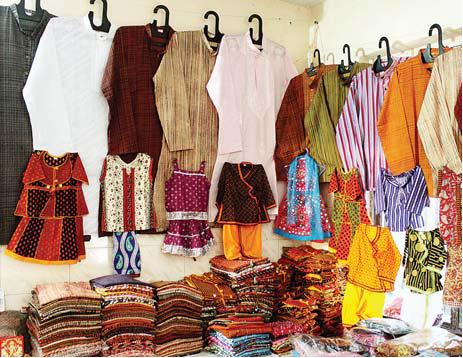Click here to view - Navarang Navaratri Colors 2013
For Navarang Navaratri Colors 2012 - click here
Navaratri colors to wear 2012
These are the colors as per Maharashtra Times newspaper.
Nine Saree colors of Navratra or Navratri 2011
As per panchang dress colour as follows :-
1) 28th September :- Green :- Amba
2) 29th September :- Greay :- Tara
3) 30th September :- Pink :- Shorashi
4) 01st October :- White :- Bhuvneshwari
5) 02nd October :- Red :- Chhinnamastaa
6) 03rd October :- Blue :- Bhairavi
7) 04th October :- Yello :- Green Dhoomavati
8) 05th October :- Violet :- Green Bagala
9) 06th October :- Peacock Green :- Matangi
During the Navratra festival Mother, as the Universal Energy is worshipped. Navratra literally means '9 nights'. During these days and nights, prayers are offered to 'Mother Goddess? Hindus believe that the Mother stands for everything that is everywhere in the Universe. The first 3 days are devoted to the worship of the Mother Kali. It is in all probability for the destruction of the evil tendencies that live within us. The 2nd, 3 days and nights are devoted to the worship of Mother Laxmi. Mother Laxmi gifts us all the wealth that we possess, and all the wonderful things that money can buy. She stands for all the abundance in every conceivable form that exists in our life. The last 3 days and nights are devoted to Mother Saraswati. Mother Saraswati, gifts us knowledge. After having cleansed ourselves, and having partaken of the necessities of life, it is time to imbibe, the knowledge and wisdom that Mother Saraswati imparts. On the 10th day, a bonfire (Havan) is lit. During the 9 days of Navratra people dance the Garba Dance. Whether we pray to Mother Goddess or not, She thinks of us all the time. She holds us in our arms when we feel sad, in the form of our own mother, or friend. Mother Laxmi gives us various gifts from time to time. As Mother Saraswati, she teaches us all the wonderful things that we need to learn. And as Mother Kali, She teaches us lessons that may be painful, but are ultimately for our own good. The all-pervading energy, source of existence, or Shakti manifests itself as creation. Shakti is the divine mother who gives birth and nurtures the new born- whether it is a new-born baby, a brand new relationship, a fresh idea, or a magical manifestation.
Although Shakti is beyond the boundaries of gender, form or colour, we call it Mother because of its mothering and creative qualities. Mother Saraswati
Mother Saraswati holds a pen in one hand which symbolizes the power to communicate through the written word. The name Saraswati is derived from the Sankrit words sara, which means, 'essence';and swa, which means, 'self'. Thus Saraswati means ?the essence of the self?. The Vedas that She holds in Her hand, summon the spirit of brilliant knowledge. Material Prosperity (Laxmi) invites knowledge(Saraswati). Goddess Saraswati represents the fine arts. Many believe that ones self-essence can be found through the use of knowledge and wisdom.The Gayatri Mantra is one of the most well-known invocations to Mother. Mother?s white saree speaks of Her purity. Her carriage is the swan. The swan is able to separate water from milk. Great Saints in the Hindu tradition are addressed as ?Param Hans? meaning a great Swan. The reason? Because great sages are able to separate good from bad, truth from falsehood and illusion, true knowledge from ignorance? Mother Saraswati is called Veena Vaadini. She plays an instrument called Veena which has seven strings. The number seven is mostly associated with the seven charkas. On either side of the veena there are two hollow rounds. Maybe those hollow globes save one from drowning in the ocean of Samsara. The parsaad offered to the Goddess are nutrients that increase the potential of the brain. The parsaad (food offering) consists of Misri (sugar) nuts, cardammon, nodes of the bamboo shoot (banslochan) and lotus seeds. The rosary made of tulsi seeds makes one consistent in the pursuit of knowledge and spirituality. For the puja of Mother Saraswati: The youngest girl applies a teeka on everyone's forehead. The other devotees then sprinkle water, and other auspicious offerings on Mother Saraswati. Aarti is performed. Parsaad for devotees consists of a few bers, a laddoo, a paan? and good will and cheer.







Nice post i really glad to read this informative post, thanks to share Navratri Return Gifts | Indian Gift Shop Online
ReplyDelete